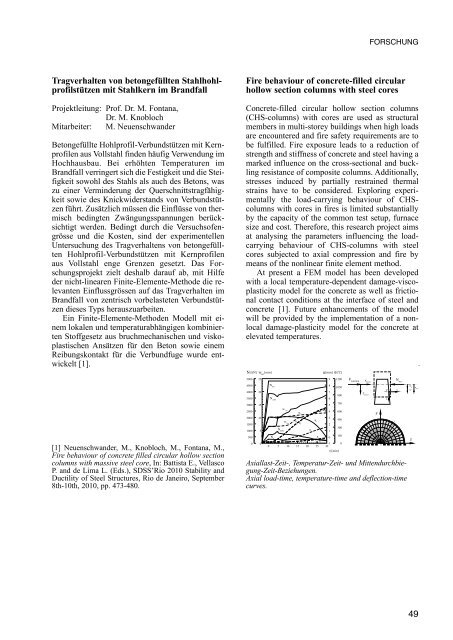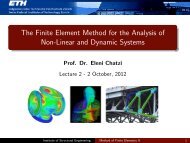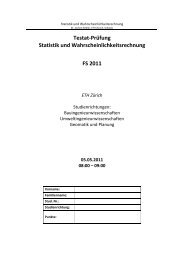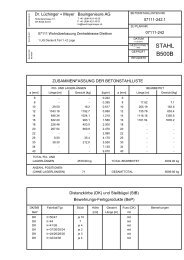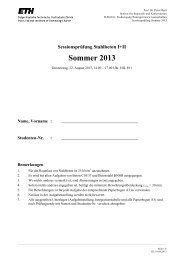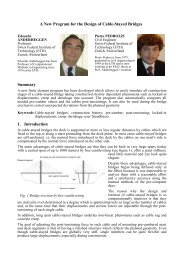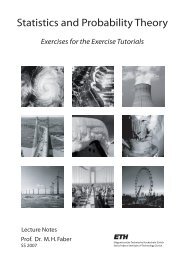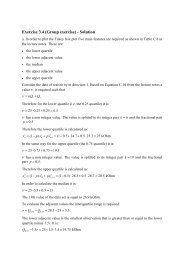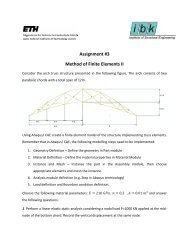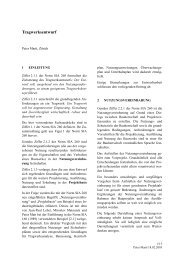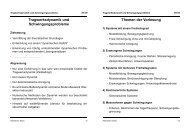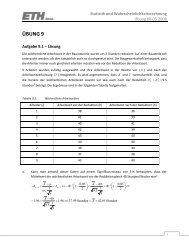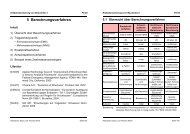JAHRESBERICHT - Institut für Baustatik und Konstruktion - ETH Zürich
JAHRESBERICHT - Institut für Baustatik und Konstruktion - ETH Zürich
JAHRESBERICHT - Institut für Baustatik und Konstruktion - ETH Zürich
Sie wollen auch ein ePaper? Erhöhen Sie die Reichweite Ihrer Titel.
YUMPU macht aus Druck-PDFs automatisch weboptimierte ePaper, die Google liebt.
FORSCHUNG<br />
Tragverhalten von betongefüllten Stahl hohl -<br />
profilstützen mit Stahlkern im Brandfall<br />
Projektleitung: Prof. Dr. M. Fontana,<br />
Dr. M. Knobloch<br />
Mitarbeiter: M. Neuenschwander<br />
Betongefüllte Hohlprofil-Verb<strong>und</strong>stützen mit Kern -<br />
profilen aus Vollstahl finden häufig Verwendung im<br />
Hochhausbau. Bei erhöhten Temperaturen im<br />
Brand fall verringert sich die Festigkeit <strong>und</strong> die Stei -<br />
fig keit sowohl des Stahls als auch des Betons, was<br />
zu einer Verminderung der Quer schnitts trag fähig -<br />
keit sowie des Knickwiderstands von Ver b<strong>und</strong> stüt -<br />
zen führt. Zusätzlich müssen die Einflüsse von thermisch<br />
bedingten Zwängungsspannungen berücksichtigt<br />
werden. Bedingt durch die Ver suchs ofen -<br />
grös se <strong>und</strong> die Kosten, sind der experimentellen<br />
Un ter suchung des Tragverhaltens von betongefüllten<br />
Hohlprofil-Verb<strong>und</strong>stützen mit Kernprofilen<br />
aus Vollstahl enge Grenzen gesetzt. Das For -<br />
schungs projekt zielt deshalb darauf ab, mit Hilfe<br />
der nicht-linearen Finite-Elemente-Methode die re -<br />
le van ten Einflussgrössen auf das Tragverhalten im<br />
Brand fall von zentrisch vorbelasteten Verb<strong>und</strong> stü t -<br />
zen dieses Typs herauszuarbeiten.<br />
Ein Finite-Elemente-Methoden Modell mit ei -<br />
nem lokalen <strong>und</strong> temperaturabhängigen kombinierten<br />
Stoffgesetz aus bruchmechanischen <strong>und</strong> vis ko -<br />
plas tischen Ansätzen <strong>für</strong> den Beton sowie einem<br />
Reibungskontakt <strong>für</strong> die Verb<strong>und</strong>fuge wurde entwickelt<br />
[1].<br />
Fire behaviour of concrete-filled circular<br />
hollow section columns with steel cores<br />
Concrete-filled circular hollow section columns<br />
(CHS-columns) with cores are used as structural<br />
members in multi-storey buildings when high loads<br />
are encountered and fire safety requirements are to<br />
be fulfilled. Fire exposure leads to a reduction of<br />
strength and stiffness of concrete and steel having a<br />
marked influence on the cross-sectional and buckling<br />
resistance of composite columns. Additionally,<br />
stresses induced by partially restrained thermal<br />
strains have to be considered. Exploring experimentally<br />
the load-carrying behaviour of CHScolumns<br />
with cores in fires is limited substantially<br />
by the capacity of the common test setup, furnace<br />
size and cost. Therefore, this research project aims<br />
at analysing the parameters influencing the loadcarrying<br />
behaviour of CHS-columns with steel<br />
cores subjected to axial compression and fire by<br />
means of the nonlinear finite element method.<br />
At present a FEM model has been developed<br />
with a local temperature-dependent damage-viscoplasticity<br />
model for the concrete as well as frictional<br />
contact conditions at the interface of steel and<br />
concrete [1]. Future enhancements of the model<br />
will be provided by the implementation of a nonlocal<br />
damage-plasticity model for the concrete at<br />
elevated temperatures.<br />
N [kN] w [mm]<br />
tot<br />
u[mm] θ[˚C]<br />
[1] Neuenschwander, M., Knobloch, M., Fontana, M.,<br />
Fire behaviour of concrete filled circular hollow section<br />
co lumns with massive steel core, In: Battista E., Vel lasco<br />
P. and de Lima L. (Eds.), SDSS’Rio 2010 Stability and<br />
Ductility of Steel Structures, Rio de Janeiro, September<br />
8th-10th, 2010, pp. 473-480.<br />
5000 25<br />
9 1200 F reaction xglobal<br />
4500<br />
N<br />
8<br />
res<br />
1050<br />
4000<br />
3500<br />
3000<br />
2500<br />
2000<br />
1500<br />
1000<br />
500<br />
20<br />
15<br />
10<br />
5<br />
N core<br />
N tube<br />
N c<br />
w<br />
1,tot<br />
u 3<br />
w θ 1<br />
3,tot<br />
1 θ 2<br />
0 0 -1 0<br />
0 5 10 15 20 25 30<br />
t [min]<br />
θ 3<br />
u<br />
θ 4<br />
θ 5<br />
Axiallast-Zeit-, Temperatur-Zeit- <strong>und</strong> Mittendurchbie -<br />
gung-Zeit-Beziehungen.<br />
Axial load-time, temperature-time and deflection-time<br />
curves.<br />
7<br />
6<br />
5<br />
4<br />
3<br />
2<br />
1<br />
0<br />
900<br />
750<br />
600<br />
450<br />
300<br />
150<br />
z<br />
global<br />
y<br />
5<br />
C<br />
z<br />
4<br />
3<br />
2<br />
1<br />
N res<br />
x<br />
w<br />
0<br />
w<br />
z<br />
e res<br />
49


